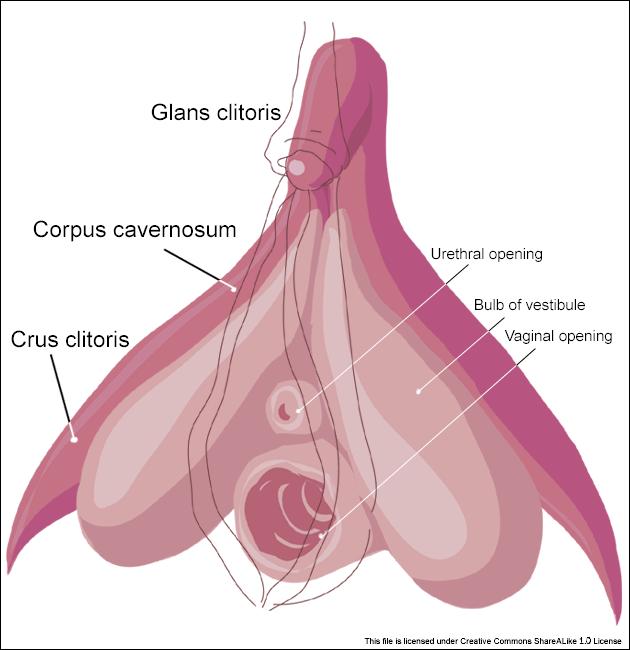Originally published on Doctor Nerdlove and republished here with the author’s permission.
One of the most common questions – according to my incoming Google searches, anyway – that guys seem to have is about casual sex: how to get it, why don’t women like it as much as they do, etc.
As I’ve said many times, the reason why women aren’t as into casual sex as men are has nothing to do with liking or disliking sex and everything with the fact that most of the time it’s not worth it.
Part of the problem is that cis men have a tendency to treat a casual hook up like a human Fleshlight. The other problem is that frankly, a lot of men suck in bed.
Frankly, I blame the schools.
No, I’m not kidding. If you’re a regular reader of this site, then you may have noticed my disdain for the way that sex ed is handled.
In the US, sex ed is a glorified anatomy lesson at best with the occasional scare-them-sexless stories of pregnancies and sexually transmitted infections if you’re lucky.
If you’re not, then you get the abstinence-only version of sex ed, which has all the scientific validity of someone who’s heard about reproduction as a concept, but isn’t too sure that it’s ever going to catch on.
Of course, just as jazz is often about the notes that aren’t played, sex ed is about what isn’t taught – and should have been.
For example, you can imagine my face when I only learned that testicular cancer was a thing because fucking Tom Green (for you young ‘uns: a mid-grade comedian mostly known for one of the shittiest movies of all time and also hooking up with Drew Barrymore) got it.
The problem is that when all anyone is taught about sex is a plumbing diagram, then they’re missing critical lessons and people will go elsewhere to fill in the gaps. This is how we end up with generations of men who’ve been taught about orgasms by Jenna Jameson and Dale DaBone.
But I’m nothing if not willing to help. Let’s talk a little about what we should be learning in sex ed.
1. This Is the Clitoris – Get to Know It
Remember what I said about the plumbing diagrams? I wasn’t kidding. Almost everything involving those anatomy lessons tends to focus on “here’s where things go out, here’s where things go in.”
Guess what they tend to leave off?
Here’s a hint: anything that relates to actual pleasure. This shouldn’t be terribly surprising; scientists have had to rediscover the actual size, shape, and location of the clitoris three separate times.
Hell, studies have found that all people, regardless of genitals, have equal likelihood of not being able to find the clitoris on a diagram. The penis, on the other hand, has been studied and celebrated pretty much as soon as humans figured out abstract reasoning and symbolic representation.
This is important because, frankly, everyone‘s a functional expert in dicks. It’s pretty much impossible to not get an education in the care and handling of dongs, but the number of dudes who understand just what it takes to get a person with a clitoris off (or, for that matter who care) is relatively miniscule.
Once again, we can blame porn for teaching generations of cis men that all it takes to make people orgasm is a horse-sized cock and the ability to imitate a flesh jackhammer.
Even the foreplay tends to involve jamming one’s fingers into a person’s vag like they’re trying to fish a quarter out of an arcade game’s coin return.
In reality however, a study has shown over 75% of cis women can’t orgasm through vaginal penetration alone and need some form of clitoral stimulation to get off.
So the first thing cis men need to do is to get more familiar with the little man in the boat.

Alright, more seriously:

Now, just knowing where the clit is doesn’t mean that your job is done, and just treating it like a vaginal doorbell means you’re going to get “the tap” during foreplay.
You know the one I mean; it’s the nonverbal pat that says “Okay, I appreciate the gesture, but you really aren’t listening, and not only can I do this better, but it’s starting to get uncomfortable, so could you just stop, please?”
While the penis has about 4,000 nerve endings, the clitoris has around 8,000, and in many people, the clitoral glans is incredibly sensitive.
Attacking it head-on can often be uncomfortable, especially if you’re just slapping at it with your fingers or tongue. Many people with a clitoris prefer indirect contact, whether to the side or just above the glans.
It’s a smarter idea to approach it with a slow pace and a feather-light touch and listen to your partner; they’ll have a better idea of whether they want it faster, slower, or harder.
Pay attention to all of this; there will be a quiz later.
Also: when your partner says “yes, right there” or “don’t stop,” this is not a sign that it’s time to fucking change things up. Seriously. You don’t know how many folks have made that exact same complaint about their boyfriends.
Speaking of complaints…
2. Sex Isn’t Just About Penetration
Pop quiz hot shot: Which of these isn’t considered actually having sex?
- Blow jobs
- Cunnilingus
- Pegging
- Tit-fucking
- Brimping
- Mutual masturbation
- Peenor into the vagoo
Trick question! They’re all ways of having sex. The problem is that sex ed doesn’t cover the fact that sex is more than tab-A-into-slot-B.
In fact, defining sex as penis-in-vagina action by default is part of what makes cis men shitty lovers. When the only thing that “counts” as “real” sex is penetration, then every other sex act becomes secondary by definition.
As a result, lots of pitiful dudes who’re pissed off that they’re not able to get their dicks wet and treat any other form of fooling around as a consolation prize instead of thinking, “Hey, blowjobs are awesome!”
The other problem is that when the only thing you’re focused on is making it to home plate is that it means that dudes tend to be bad at everything but fucking.
Every other form of sexual contact isn’t something to be enjoyed in and of itself. It’s part of the pre-flight check-list that you have to step through in order to get your flesh-plane onto the runway.
It’s bad enough when guys treat, say, cunnilingus as something to brag about rather than something they do for their partner’s pleasure; it’s worse when the dude gives only the most perfunctory performance because it’s the prerequisite to pud-pounding. By that point, it’s almost insultingly bad.
The other benefit to expanding the definition of sex is that it takes the (self-imposed) pressure off men to perform like porn stars.
Another factoid that never comes up during sex ed is that penetration on average lasts around 5-7 minutes from start to (penial) orgasm and when men can’t measure up to their (highly edited) porn idols, they freak out.
Expanding the definition of sex to include more than just penetration takes the pressure off cis men to measure their skill as a lover strictly by how long it takes them to get off and puts the emphasis more on their ability to be creative and giving.
But while we’re talking about orgasms…
3. Your Orgasm Isn’t the (Only) Goal
Another issue with making sex all about the penis and what you’re doing with it is that it tends to mean that the cis man’s orgasm is the sexual equivalent to the bird at the beginning of the Flintstones. As soon as it goes off, it’s quittin’ time.

And therein lies the problem.
Remember what I was saying about the mechanics of the clitoris and the clitoral orgasm earlier? Because most cis women don’t get off through penetration and 99.999% of cis men do, the odds that a cis woman is going to get off are less than 20%, while cis men are almost guaranteed to get theirs.
Then there’s the fact that for many people with clitorises, orgasms can take time, even with the partner who can lick his own eyebrows and breathe through their ears.
Hell, some cis women require direct and intense stimulation that can only be provided by sex toys.
And then, of course, there’s the fact that cis men go through a refractory period that makes maintaining an erection or achieving an orgasm again difficult to actively impossible in the immediate future, which means that they tend to lose interest in anything sexual.
Combine that with sex ed that discusses ejaculation, but not orgasms, and a lifetime of pop culture that teaches us that sex ends when the man comes, and you get a culture that teaches us that when we pop our corks, the show’s over.
As a result, under standard definitions of sex, a cis man’s orgasm is inevitable, a cis woman’s is “optional.”
This goes hand in hand with the “got mine, fuck you” attitude that many cis men bring to casual hook-ups – “mine’s easy, yours takes work,” and if you’re not going to see them again, then who cares?
Of course, that same general attitude is why many cis women don’t want to hook up. Why put up with a night of mediocre sex and awkward “do I have to stay over?” conversations when she’s got Netflix and a perfectly good vibrator?
Just as expanding your definition of sex helps make you a better lover, so does changing how you treat the goal of sex. Rather than focusing on getting off, you want to focus on mutual pleasure.
Focusing on mutual pleasure and satisfaction changes the equation; it becomes less about orgasm parity or who comes when and more about a collaborative effort in pleasing everyone.
It means that guys who don’t have the hang time they might wish for can still please their partners – switching to tongues, fingers, or even toys – while cis women don’t feel pressured to try to get off within the narrow window of “between when the dude gets an erection” and “when he blows his load and starts to snore.”
Similarly, when someone can’t orgasm for whatever reason (and yes, this happens to cis men more than they will admit), it doesn’t mean that everything is a failure; you just shift your focus.
Treating your partner’s pleasure as important – even in a casual hook-up – is part of what makes you a masterful lover, not treating orgasms like a badge of honor (when you can be bothered).
4. You Need to Talk the Talk
Another issue that comes up frequently when it comes to sex ed: We talk about the mechanics of it, but not how to get it. Not in the sense of teaching pick-up in classrooms mind you, but in the sense of how we’re supposed to talk about sex with our prospective partners.
For example: Sex ed doesn’t cover issues of consent – not just issues of “no means no,” but how to check in with your partner, that consent is granular and can be revoked at any time for any reason.
Instead of treating sex as something that “just happens,” we need to view sex as something we talk about – even with a hook-up – as well as what a genuine yes looks like versus one that’s obtained through pressure or coercion.
And part of talking about sex means asking the question of “so, what are you up for?” As Dan Savage has said regularly, in gay and lesbian hook-ups, not every act is presumed to be on the table. Many gay men aren’t into anal sex. Many lesbians aren’t into every form of lady-boning there is.
Part of the hooking up process involves asking what your partner’s interests and limits are and adjusting plans accordingly.
In adopting this model, it helps ensure not only that consent is explicit and not just assumed, but it also lessens the pressure for one partner or the other to perform in ways that they may not be interested or able to.
Some people may be down for oral, but not penetration. They may be down for penetration and giving oral, but being on the receiving end gives them the screaming ab-dabs. The more you’re able to communicate with your partner, the better your sex will be.
Which is why…
5. Your Best Sex May Be in a Relationship (But You’ll Want to Bang Other People, Too)
Most sex ed classes will emphasize monogamy and not without reason. Part of what makes for great sex is communication, mutual experience, and trust – and those are hard to find in a one-night stand.
In fact, studies have found that the more times a pair has hooked up, the more likely it is that both parties will get off.
This isn’t exactly a surprise: They’re both building on previous experience, as well as increased familiarity and intimacy. After all, when you’re hooking up with someone for the first time, you don’t know anything about them or what gets their motor humming.
No matter what any AskMen column may tell you, there are no universal techniques that all people love, so every first encounter is a matter of trial and error.
But those subsequent get-togethers mean that this time, you know that if you nibble right there, you get that reaction, while doing this makes her feel like her skin is trying to crawl off.
But part of what they don’t teach in sex ed classes is that you will want novelty, too. Just because you’re having amazing sex with your partner doesn’t mean that you won’t be interested in banging someone else.
The desire to sleep with other people doesn’t go away forever just because you’re in a relationship with someone, but it also doesn’t mean that there’s something wrong with your relationship when you find yourself eyeing Sheila over in Accounts Receivable.
Similarly, it doesn’t mean that you’re not doing your job just because your partner is imagining what it’d be like to sneak off into the broom closet with that Joseph Gordon-Levitt look-alike she’s noticed at work.
This doesn’t mean that either of you is about to (or is even interested in trying to) turn fantasy into reality – a boner isn’t a mandate to be fulfilled – but how much heartache could we avoid if we were taught that these feelings are natural when we’re learning about the birds and bees?
Editor’s Note: Additionally, monogamy is not always the right option for people. Polyamory and other forms of non-monogamy are also valid forms of love and relationships.
Sex is complicated and messy enough when you’re crossing your fingers that you get everything else right. It takes an education to become a masterful lover. Teaching the right lessons means the difference between a disappointing encounter and sex that everyone enjoys.
[do_widget id=’text-101′]
Dr. NerdLove dispenses love, sex and life advice for geeks, otaku, dweebs, poozers, nerds and the occasional neo-maxie-zoom-dweebie. Making geeks sexier since 2011. Check out his website here and follow him on Twitter @DrNerdLove.
Search our 3000+ articles!
Read our articles about:
Our online racial justice training
Used by hundreds of universities, non-profits, and businesses.
Click to learn more





















